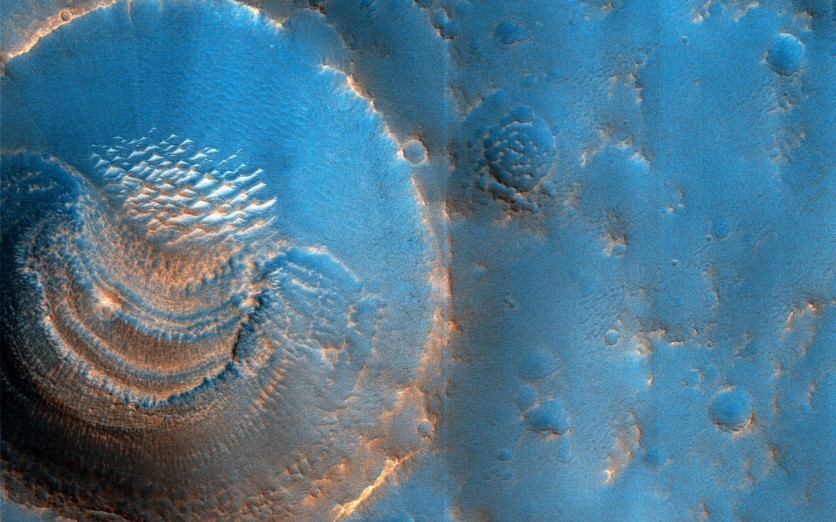NASA has been exploring several regions of the Red Planet for years now to search for signs of life. And although there is still no definite answer to David Bowie's "is there life on Mars?", this planet has been gracing us with fascinating and peculiar views thanks to NASA's robotic explorer missions.
For instance, this image taken on Oct. 23 and published on NASA's website on Dec. 29, depicts a Martian crater covered in majestic hues of blue.
But beyond its beauty is also a mystery waiting to be unraveled.

Arabia Terra
The HiRISE instrument from the Mars Reconnaissance Orbiter Spacecraft's centered its eyes on the northern plains of Arabia Terra and captured craters that contain unknown deposits with peculiar shapes and distribution.
According to NASA, deposits are only observed in craters greater than 600 meters in diameter, and they are typically found on the south sides of the craters rather than the north.
These structures may have been created by the sublimation of ice-rich material, as per scientists.
The space agency also notes that HiRISE photographs frequently elicit more questions than they provide answers. For instance, this view of the northern Arabia Terra plains displays craters that house odd deposits that remain unknown to this day.
The deposits have layers or terrace-like horizontal laminations. The sediments also include microscopic, brilliant ridges that form radial striations.
NASA believes that ice-rich material sublimated to create these characteristics. The terraces can represent various sublimation epochs. It's also possible that the deeper, larger craters reached a water table between 45 and 60 meters below the surface and were later flooded.
HiRISE, which was created by Boulder, Colorado-based Ball Aerospace & Technologies Corp., is run by the University of Arizona in Tucson.
The Mars Reconnaissance Orbiter Project is overseen by NASA's Jet Propulsion Laboratory, a branch of Caltech in Pasadena, California, on behalf of NASA's Science Mission Directorate in Washington.
Read Also : Liquid Water on Mars? Scientists Reveal New Study Which May Prove This Claim About the Red Planet
Winter Wonderland on Mars
NASA has also released an image of what the Red Planet looks like during winter using the HiRISE camera. It features sand dunes in striking details covered in blue first after Mars went through a winter solstice.

According to NASA, some of the coldest snowfall on Mars occurs in its poles, where it can get down to minus 190 degrees (minus 123 degrees Celsius).
However, snow only accumulates in a few places on Mars, and the majority of it does so on flat ground.
Due to Mars' eccentric orbit, one Mars year is roughly equivalent to two Earth years, and winter arrives on the Red Planet much later than it does on our planet.
However, scientists now have the chance to study the planet's unique winter phenomena thanks to NASA's robotic Mars explorers.
Related Article : Garbage on Mars: Over 15,000 Pounds of Human Trash Pile up on the Red Planet, Researcher Says

ⓒ 2025 TECHTIMES.com All rights reserved. Do not reproduce without permission.




